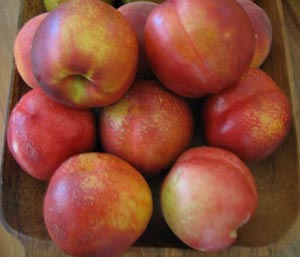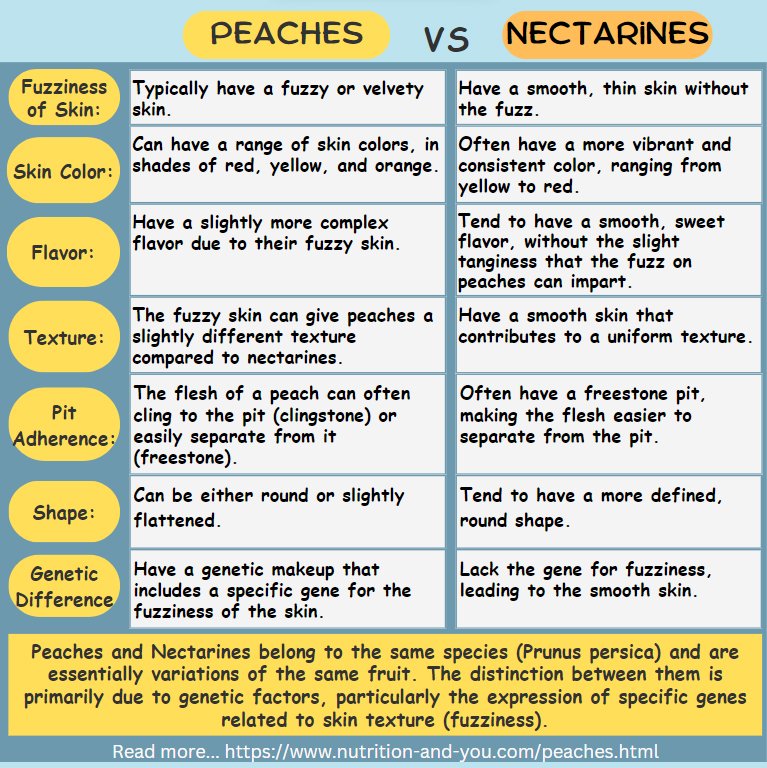Nectarine Nutrition facts
Sweet, delicious nectarine is a closely related fruit species to peaches. As in peach, it also can be described as a drupe (fruit flesh surrounded by central solitary, hard seed) belonging to the genus: Prunus, a large group of tree fruits, which also includes plums, damson, almonds, etc.
This novel fruit is appreciated worldwide for its juicy, fragrant aroma, and unique taste. It thought to have originated in China and from were spread to Central Asia and Persia to Europe through the ancient silk route.
Scientific name: Prunus persica var. nucipersica.
 |
| Nectarines! Photo courtesy: lilbear |
Nectarine is a medium-sized deciduous tree with arching branches. It requires an icy winter season followed by warm weather for the proper development of buds. White or pinkish-white flowers appear in early spring, which develops subsequently into beautiful fruits by June.
The nectarine looks the same as that of peach. However, it tends to be smaller and has a smooth surface, unlike fuzzy in the case of peach. As in peach, it features a vertical furrow that extends from the stem end up to its tip.
Internally, its flesh is juicy; and depending upon the variety, it can be creamy yellow or white in color with centrally placed single, hard seed (stone). The seed is inedible. Depending on the seed that is free or firmly attached to the surrounding flesh, nectarines can be classified into free-stone or clinging varieties.
Nectarines and are closely related fruits, belonging to the same species (Prunus persica). The distinction between them is primarily due to genetic factors, particularly the expression of specific genes related to skin texture (fuzziness).
See the differences between Peaches and Nectarines in an infographic:
 |
Health benefits of Nectarine
Juicy, delicious nectarines are low in calories (100 g just provides 44 calories) and contain no saturated fats. They are indeed packed with numerous health-promoting antioxidants, plant nutrients, minerals, and vitamins.
The total measured antioxidant strength (ORAC value) of 100 g raw nectarine fruit is 750 TE (Trolox equivalents).
Fresh nectarines carry small amounts of vitamin C. 100 g provides 5.4 mg or about 9% of daily recommended levels. Vitamin C is a powerful water-soluble antioxidant. It is required for connective tissue formation within the human body. Consumption of fruits rich in vitamin C helps the body develop resistance against infectious agents and helps scavenges harmful free radicals.
Nectarines have small but healthy concentrations of other anti-oxidant vitamins such as vitamin A, vitamin E, and flavonoid polyphenolic antioxidants lutein, zeaxanthin and ß-cryptoxanthin. These compounds help act as protective scavengers against oxygen-derived free radicals and reactive oxygen species (ROS) that play a role in aging and various disease processes.
Further, vitamin A is also required for maintaining healthy mucosa and skin. Consumption of natural fruits rich in vitamin A is known to offer protection from lung and oral cavity cancers.
The fruit is a healthy source of some B-complex vitamins and minerals. It is good in niacin, pantothenic acid, thiamin, and pyridoxine.
Also, it contains modest levels of minerals and electrolytes such as potassium, iron, zinc, copper, and phosphorus. Iron is required for red blood cell formation. potassium is an important component of cells and body fluids that help regulate heart rate and blood pressure.
| Principle | Nutrient Value | Percent of RDA |
|---|---|---|
| Energy | 44 Kcal | 2% |
| Carbohydrates | 10.55 g | 8% |
| Protein | 1.06 g | 2% |
| Total Fat | 0.32 g | 1% |
| Cholesterol | 0 mg | 0% |
| Dietary Fiber | 1.7 g | 5% |
| Vitamins | ||
| Folates | 5 µg | 1% |
| Niacin | 1.125 mg | 7% |
| Pantothenic acid | 0.185 mg | 4% |
| Pyridoxine | 0.025 mg | 2% |
| Riboflavin | 0.027 mg | 2% |
| Thiamin | 0.034 mg | 3% |
| Vitamin A | 332 IU | 11% |
| Vitamin C | 5.4 mg | 9% |
| Vitamin E | 0.77 mg | 5% |
| Vitamin K | 2.2µg | 2% |
| Electrolytes | ||
| Sodium | 0 mg | 0% |
| Potassium | 201 mg | 4% |
| Minerals | ||
| Calcium | 6 mg | 0.6% |
| Copper | 0.086 mg | 9% |
| Iron | 0.28 mg | 3.5% |
| Magnesium | 9 mg | 2% |
| Manganese | 0.54 mg | 2.5% |
| Phosphorus | 26 mg | 4% |
| Zinc | 0.17 mg | 1.5% |
| Phyto-nutrients | ||
| Carotene-ß | 150 µg | -- |
| Crypto-xanthin-ß | 98 µg | -- |
| Lutein-zeaxanthin | 130 µg | -- |
Selection and Storage
Nectarine season lasts from mid-June until the end of September. In the fruit markets, one might come across several varieties of fresh nectarines. Look for well-ripen soft fruit with a smooth surface.
Avoid hard, immature ones, as they are harvested prematurely and hence, off-flavored. Furthermore, avoid those with signs of surface blemishes, shriveled, cracks, and punctures.
As in pears, it is natural and an acceptable characteristic for nectarines to have russet-brown speckled patches on their surface.
Slightly hard, but mature nectarines can be kept at room temperature until they ripen. The ripening process may be enhanced by using ethylene spray or applying other methods while ripening a href="banana-fruit.html">bananas. Storing in a paper bag concentrates this gas and hastens ripening process.
Ripe nectarine perishes early and should be placed in the refrigerator but should be brought to room temperature before eating to enjoy its rich natural flavor.
Preparation and Serving tips
Juicy nectarines have a delicious flavor and sweet creamy-yellow flesh. Choose only fresh ripe fruits to eat; immature ones are quite tart, and hence, off-flavored.
To prepare, gently wash them in cold water, and mop them dry using a soft cloth. The fruit can be consumed raw along with its skin as in apples. One can also cut the fruit into two halves and separate the pit (seed) using a knife.
To peel, use the same technique as in peaches. Score a small cross at the base. Dip in boiling water just for a minute and immediately immerse in cold water to cool quickly. Then peel the skin away from the cross.
Here are some serving tips:
| Delicious nectarine tart. Photo courtesy: The essential vegetarian cookbook. |
Nectarine is generally relished as it is, without any seasonings or additions.
Prepare a mouth-watering Frech toast with nectarine compote.
Its slices can be added to fruit salads and desserts.
The fruit can be used to make jams, jelly, and mixed fruit desserts.
It can also be used in preparing pie, crumble, soup, tart, cheesecake, etc.
Safety profile
Allergic reactions to nectarine are rare. It is well tolerated by children as well as in pregnant women.
Read further on:
≻≻ Do Potassium-Rich Foods Help Lower Blood Pressure?
≻≻- Back to Fruits from Nectarine. Visit here for an impressive list of all varieties of fruits with complete illustrations of their nutrition facts and health benefits.
≻≻- Back to Home page.
Further reading and Resources:
Peaches and Nectarine-Peach cultivars.
Stanford School of Medicine Cancer information Page- Nutrition to Reduce Cancer Risk. (Link opens in new window).